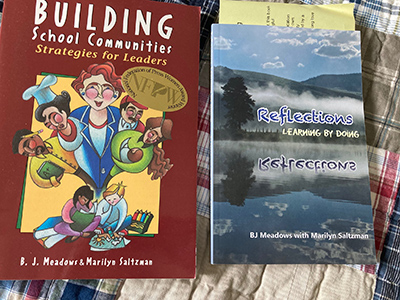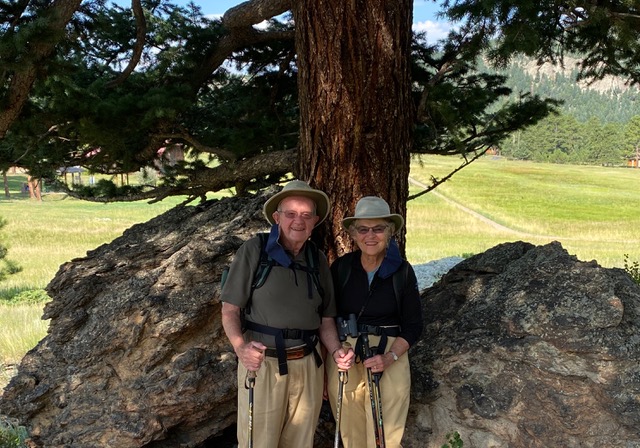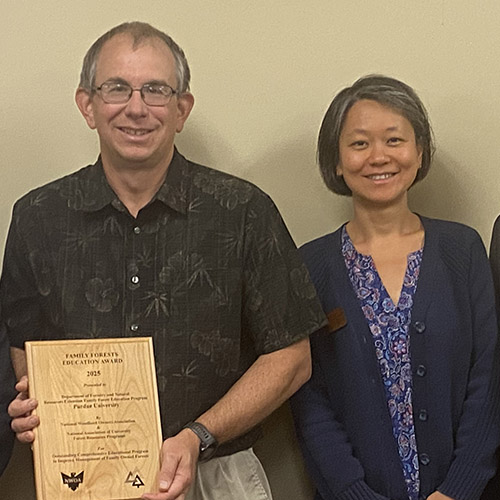Forestry & Natural Resources
Meadows Blazes Trail for Women in Forestry and Natural Resources
For B.J. Meadows, who became the first female graduate of Purdue’s master’s degree in forestry program in 1963, following her dreams meant overcoming many potential obstacles and blazing her own trail on the way to a career of fostering a love for the environment in young and old alike.
Meadows, then Betty Jane Gough, came to Purdue in 1962 after graduating from Hanover College with a degree in science and philosophy with an emphasis in biology. She began work on her master’s thesis titled the “Ecological Study of Hawkins Wildlife Area” under Dr. Russell E. Mumford with the goal of someday becoming a forest ranger.
Meadows’ roots in and love of nature, however, began much sooner.
 “I was so fortunate that my mother loved the environment,” Meadows recalls. “We lived maybe half a block from a beech/maple forest in New Castle, Indiana. She encouraged me to go spend time out in the environment, and she often would go over there with me and we would enjoy the flowers starting to bloom in the spring and the birds singing. Because my parents were so in love with nature, I had the passion for understanding nature better and as well as my relationship with nature. That was a big framework to get me started in my joy of the environment. “
“I was so fortunate that my mother loved the environment,” Meadows recalls. “We lived maybe half a block from a beech/maple forest in New Castle, Indiana. She encouraged me to go spend time out in the environment, and she often would go over there with me and we would enjoy the flowers starting to bloom in the spring and the birds singing. Because my parents were so in love with nature, I had the passion for understanding nature better and as well as my relationship with nature. That was a big framework to get me started in my joy of the environment. “Upon arrival at Hanover College, Meadows’ love of the environment was fostered by a biology professor who got her involved in doing a breeding and bird census study near the school. That research resulted in two publications, “Breeding Bird Census of Maple-Beech Forrest” (Audubon Field Notes vol. 16, no. 6, December 1962, page 521-522) and “Breeding Bird Census of Mixed Deciduous Forrest” (Audubon Field Notes: vol. 16, no. 6, Dec. 1962, p. 522).
Meadows continued to build on her previous work once on the Purdue campus, where she joined her high school sweetheart, Harold “Bud” Meadows. Bud had received his bachelor’s degree in pharmacy in West Lafayette, while B.J. was at Hanover. The pair got married in 1963 and both began working on their master’s degrees at Purdue, B.J. in forestry and Bud in bionucleonics.
“We had a mutual love for the environment and being outside together, and we still do,” B.J. explains. “He has been so supportive all along. That was one of the reasons I was so attracted to him. We were a team. The fact that we can work as a team, instead of it being my way or his way, and that we can collaborate and make it work together, that makes it enjoyable.”
The pair, who met in high school through the science club and has been married 57 years, put that teamwork on display throughout their time at Purdue. B.J. was introduced to a wildlife management area near the Purdue campus (Hawkins Wildlife Area) by professor Russell E. Mumford. When she went out and studied the birds, mammals and plants and their interrelationship, Bud was often by her side helping her in the field.
“(Professor) Russ Mumford knew about the Hawkins Wildlife Area and my interest in the environment,” Meadows recalls. “He went out there with me and helped me look at it and actually stake it out. My husband actually continued to help me stake it out and then I would go out there at least once a week to census the birds, mammals and plants to see the relationship of those. Nobody had ever valued that area and I thought that if I quantified what was out there in terms of birds and mammals and plants, then maybe people would get more interested in it.”
Mumford also played another key role in Meadows’ success at Purdue, fighting for her right to take a required class never before available to females.
“I was passionate about getting my degree and then my advisor said this class is required but you can’t enroll, because you are a female and it requires an overnight workshop and they don’t allow women to do that,” Meadows said. “I was so frustrated, but fortunately Professor Mumford came to my support and made it possible for me to take that class and then I was able to get my degree.
“As a woman, I wasn’t taken all that seriously, because women just didn’t do that (forestry) and women weren’t being hired in that area. At first, I felt kind of like I was out on my own, but I felt like I was able to be a trailblazer with the support of Mumford. There were others that supported me but he stands out as my most active advocate.”
 Despite overcoming roadblocks on the way getting her degree, Meadows still had to face a world that wasn’t quite prepared to hire women in the careers of forestry and wildlife management. But that again just brought forth her trailblazing spirit and she did it her own way.
Despite overcoming roadblocks on the way getting her degree, Meadows still had to face a world that wasn’t quite prepared to hire women in the careers of forestry and wildlife management. But that again just brought forth her trailblazing spirit and she did it her own way.“They weren’t hiring women forest rangers at the time, so I became an educator and have managed wildlife ever since,” Meadows states matter of faculty and with a slight chuckle. “I was so interested in the environment from my previous history and my love of nature that I was captivated by the idea of building classrooms that got students into the environment. That was my passion for 30 years as an educator in the Jefferson County schools. I was able to use what I had learned at Purdue in terms of wildlife management and translate it into education.”
Although she may not have known it at the time, Meadows was setting up the future of women in the forestry and wildlife fields as well as in the Purdue Department of Forestry and Natural Resources. The department’s faculty now includes several female members, while the student population across the forestry, wildlife and aquatic sciences majors is nearly 60 percent female. Alumna Amanda Wuestefeld is now the director of the Indiana Division of Fish and Wildlife and several other women have made headway in research and leadership with the U.S. Forest Service and beyond.
“I hope I led the way for them,” Meadows said humbly. “It makes me feel really good to hear of their success. I felt like a trailblazer at the time, but there were a lot of mentors that worked with me to help me be successful at it. That has been my goal too -- to mentor other people in this whole process of learning by doing and being an advocate for the environment. We are all intertwined as we know, but we kind of forget that as humans. We don’t always see all of the connections.”
Making an Impact on Environmental Education
Getting out in nature to learn as opposed to reading and taking tests would not only prove to be the preferred method for Meadows throughout her own education, but also throughout her career as a teacher, administrator and program coordinator in environmental studies.
Getting out in nature to learn as opposed to reading and taking tests would not only prove to be the preferred method for Meadows throughout her own education, but also throughout her career as a teacher, administrator and program coordinator in environmental studies.
When Meadows went to work as a biology teacher at Alameda High School in Lakewood, Colorado, in 1966, her students were assembled in a closed classroom with no windows. Frustration, however, as has become standard in Meadows’ life and career, brought a workaround and results.
Meadows went to her school principal and asked if she could take her students out into the environment, instead of just having them read about it in a text book. It took a few years, but soon field biology was part of the curriculum for Jefferson County Schools. The movement spread to many of the area high schools and Meadows would go on to earn the Outstanding Biology Teacher Award for the state of Colorado in 1971.
“Learning by doing is the theme of my whole career,” Meadows said. “One of my main goals was to integrate all of the disciplines, because at that point, each discipline – science, social studies, language arts – was taught separately and it was so regimented. Through environmental education I could integrate those disciplines and help students understand how they interact. I was really fortunate that the coordinator of science was interested in promoting environmental education and he was instrumental in helping get a K-12 environmental ed program started.”
Once the program was formed, Meadows was eventually named as its coordinator in 1974, a position she served in until 1983. Under her leadership, several programs were created to expose students to nature and to integrate the different subjects with the natural world.
In conjunction with individual subject matter directors, Meadows developed the Day on the Prairie program for seventh graders, Topics in Applied Science for eighth graders and Contemporary American Issues for 10th graders among others.
A program called Foothills and Freeways, took third grade students into the environments in the foothills of Colorado, as well as to the downtown environments, allowing them to compare the two and understand the importance for people in the urban environment to have accessibility to nature and open spaces and to appreciate their connection with nature.
The Eagle’s Nest and Owl’s Roost Environmental Discovery program, which received the National Science Teacher’s Award for Excellence in 1983, was developed for third and fourth grade students. The ENOR program had a lasting impact and still operates through Colorado State University’s Extension efforts today.
Sharing Knowledge/Encouraging Lifelong Learning
Meadows would go on into administration, working as assistant principal and co-principal at Normandy Elementary School. She then was principal of three elementary schools before opening the new Ryan Elementary School, which was named after a student who had recently died of AIDS.
Meadows would go on into administration, working as assistant principal and co-principal at Normandy Elementary School. She then was principal of three elementary schools before opening the new Ryan Elementary School, which was named after a student who had recently died of AIDS.
She then spent 10 years as an evaluator for the National Science Foundation, helping evaluate the effectiveness of partnerships between industry and universities, looking at how they connected, shared information and learned from each other to build more effective products and increased each other’s knowledge base.
Meadows made an impact through several professional organizations and relationships, working with the Colorado State Extension advisory board, the Colorado governor’s Energy Task Force, as a Nature Conservancy trustee, and as part of the North American Association of Environmental Education board of directors.
Through the Nature Conservancy, and with the help of her students, Meadows was able to bring more ways to experience nature to the residents in Jefferson County.
“The students actually went down to the town council and helped promote the acquisition of open spaces, which is pretty strong now in Jefferson County and even more important now that we have more people in Colorado,” Meadows recalls. “Part of the project was to make the natural environment a part of the urban environment through the parks/open spaces that are available. Some of those spaces include trails and a lot of them feature educational information about the environment.”
Meadows went on to write two books sharing her knowledge of the world of academia as well as her passion for the environment and how it shaped her life and career. Building School Communities Strategies for Leaders was published in 2000 and Reflections, Learning by Doing came out in 2014.
 Ann M. Brady, the former superintendent of schools in Telluride, Colorado, shared the impact of Meadows’ first book, stating on the book’s back cover that Building School Communities Strategies was “A book all school administrators should have on their desk. The authors demonstrate how collaborative decision making can produce satisfying solutions to the intricate dilemmas school administrators face every day.”
Ann M. Brady, the former superintendent of schools in Telluride, Colorado, shared the impact of Meadows’ first book, stating on the book’s back cover that Building School Communities Strategies was “A book all school administrators should have on their desk. The authors demonstrate how collaborative decision making can produce satisfying solutions to the intricate dilemmas school administrators face every day.”Meadows’ memoir Reflections brought high praise from former colleague Sharon R. Moore, who worked with the Eagle’s Nest and Owl’s Roost program through Colorado State Extension.
“B.J. Meadows realized early on how experiential learning in the outdoors captivated her, resulting in an excitement for learning,” Moore said on the book’s inside cover. “Recognizing the value of learning by experience, B.J. dedicated her career to creating experiential learning experiences for her students and peers, overcoming opposition and many obstacles to do so. Because of her dedication many students have been and continue to be positively impacted by the programs and curriculum she has created, that have withstood the test of time and are still in practice today.”
Even in retirement, Meadows continues to promote environmental education to her peers. She works with the Osher Lifelong Learning Institute (OLLI - https://universitycollege.du.edu/olli/) program sponsored by the University of Denver. Meadows has taught classes based on her books as well as a class called Aging Adventures, where she and fellow adults age 50 and “better” learn to be lifelong learners together and share their experiences. She also is a facilitator for more experiential learning through Going Deeper groups, which help people get in touch with what is most important to them, working together in groups to share ideas.
Still Experiencing Nature
 Meadows, who turned 80 on August 21, still finds excitement and joy spending her days in nature. B.J. and her husband Bud usually take a two and a half to three mile hike up to the South Table Mountains near their home to observe the birds and plants and animals each day.
Meadows, who turned 80 on August 21, still finds excitement and joy spending her days in nature. B.J. and her husband Bud usually take a two and a half to three mile hike up to the South Table Mountains near their home to observe the birds and plants and animals each day.
 Meadows, who turned 80 on August 21, still finds excitement and joy spending her days in nature. B.J. and her husband Bud usually take a two and a half to three mile hike up to the South Table Mountains near their home to observe the birds and plants and animals each day.
Meadows, who turned 80 on August 21, still finds excitement and joy spending her days in nature. B.J. and her husband Bud usually take a two and a half to three mile hike up to the South Table Mountains near their home to observe the birds and plants and animals each day.“It makes me feel better,” Meadows says. “I like the exercise, but above that, I like the contact with nature. It makes me feel better and more energized to observe the trees and the flowers and the changes over the seasons.”
That school girl who grew up in the shadow of beech and maple trees continues to spend her life helping others find their passion for and connection to the environment.
For her impact to the generations of women in forestry, wildlife management, and environmental studies who have followed in her trailblazing footsteps, as well as her push to bring the outdoors to students of all ages, a debt of gratitude is surely owed. Meadows has truly followed her dreams, never detoured by obstacles, and while living her life to the fullest and bringing the rest of the world along to enjoy the journey.
Biology Goes Outdoors
a poem by B.J. Meadows, 2019
a poem by B.J. Meadows, 2019
Gratitude for childhood nature adventures
mother encouraging me spending time in woodlot
close to home…my favorite classroom
mother encouraging me spending time in woodlot
close to home…my favorite classroom
Devoting life to teaching and learning
honoring all learning styles
mentoring many
honoring all learning styles
mentoring many
Teaching lab science is engaging
staying indoors is frustrating
Open Space Lands will be our classroom
staying indoors is frustrating
Open Space Lands will be our classroom
What kinds of ducks are these?
there’s an owl with long ears
what does it eat?
does it live here year round?
there’s an owl with long ears
what does it eat?
does it live here year round?
How will you find the answers?
what are you seeing, hearing, smelling?
what are you seeing, hearing, smelling?
Do we have to go back to school, Dr. Meadows?
this is our real classroom
let’s stay all day!
this is our real classroom
let’s stay all day!






